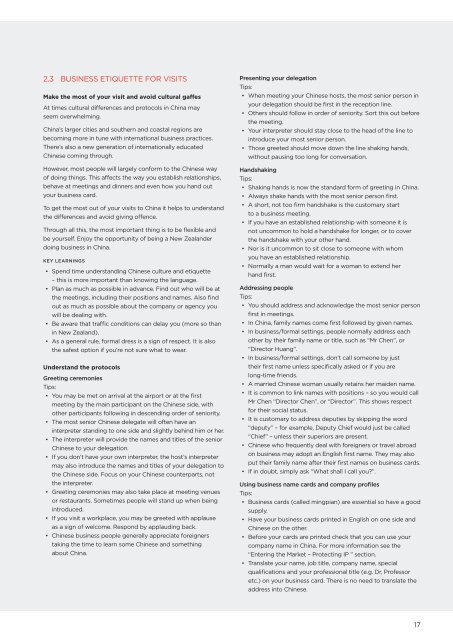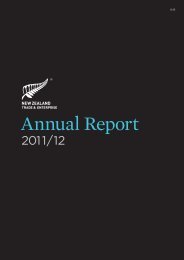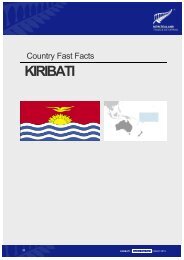Navigating China Guide (2012) - New Zealand Trade and Enterprise
Navigating China Guide (2012) - New Zealand Trade and Enterprise
Navigating China Guide (2012) - New Zealand Trade and Enterprise
Create successful ePaper yourself
Turn your PDF publications into a flip-book with our unique Google optimized e-Paper software.
2.3 BUSINESS ETIQUETTE FOR VISITS<br />
Make the most of your visit <strong>and</strong> avoid cultural gaffes<br />
At times cultural differences <strong>and</strong> protocols in <strong>China</strong> may<br />
seem overwhelming.<br />
<strong>China</strong>’s larger cities <strong>and</strong> southern <strong>and</strong> coastal regions are<br />
becoming more in tune with international business practices.<br />
There’s also a new generation of internationally educated<br />
Chinese coming through.<br />
However, most people will largely conform to the Chinese way<br />
of doing things. This affects the way you establish relationships,<br />
behave at meetings <strong>and</strong> dinners <strong>and</strong> even how you h<strong>and</strong> out<br />
your business card.<br />
To get the most out of your visits to <strong>China</strong> it helps to underst<strong>and</strong><br />
the differences <strong>and</strong> avoid giving offence.<br />
Through all this, the most important thing is to be flexible <strong>and</strong><br />
be yourself. Enjoy the opportunity of being a <strong>New</strong> <strong>Zeal<strong>and</strong></strong>er<br />
doing business in <strong>China</strong>.<br />
KEY LEARNINGS<br />
• Spend time underst<strong>and</strong>ing Chinese culture <strong>and</strong> etiquette<br />
– this is more important than knowing the language.<br />
• Plan as much as possible in advance. Find out who will be at<br />
the meetings, including their positions <strong>and</strong> names. Also find<br />
out as much as possible about the company or agency you<br />
will be dealing with.<br />
• Be aware that traffic conditions can delay you (more so than<br />
in <strong>New</strong> <strong>Zeal<strong>and</strong></strong>).<br />
• As a general rule, formal dress is a sign of respect. It is also<br />
the safest option if you’re not sure what to wear.<br />
Underst<strong>and</strong> the protocols<br />
Greeting ceremonies<br />
Tips:<br />
• You may be met on arrival at the airport or at the first<br />
meeting by the main participant on the Chinese side, with<br />
other participants following in descending order of seniority.<br />
• The most senior Chinese delegate will often have an<br />
interpreter st<strong>and</strong>ing to one side <strong>and</strong> slightly behind him or her.<br />
• The interpreter will provide the names <strong>and</strong> titles of the senior<br />
Chinese to your delegation.<br />
• If you don’t have your own interpreter, the host’s interpreter<br />
may also introduce the names <strong>and</strong> titles of your delegation to<br />
the Chinese side. Focus on your Chinese counterparts, not<br />
the interpreter.<br />
• Greeting ceremonies may also take place at meeting venues<br />
or restaurants. Sometimes people will st<strong>and</strong> up when being<br />
introduced.<br />
• If you visit a workplace, you may be greeted with applause<br />
as a sign of welcome. Respond by applauding back.<br />
• Chinese business people generally appreciate foreigners<br />
taking the time to learn some Chinese <strong>and</strong> something<br />
about <strong>China</strong>.<br />
Presenting your delegation<br />
Tips:<br />
• When meeting your Chinese hosts, the most senior person in<br />
your delegation should be first in the reception line.<br />
• Others should follow in order of seniority. Sort this out before<br />
the meeting.<br />
• Your interpreter should stay close to the head of the line to<br />
introduce your most senior person.<br />
• Those greeted should move down the line shaking h<strong>and</strong>s,<br />
without pausing too long for conversation.<br />
H<strong>and</strong>shaking<br />
Tips:<br />
• Shaking h<strong>and</strong>s is now the st<strong>and</strong>ard form of greeting in <strong>China</strong>.<br />
• Always shake h<strong>and</strong>s with the most senior person first.<br />
• A short, not too firm h<strong>and</strong>shake is the customary start<br />
to a business meeting.<br />
• If you have an established relationship with someone it is<br />
not uncommon to hold a h<strong>and</strong>shake for longer, or to cover<br />
the h<strong>and</strong>shake with your other h<strong>and</strong>.<br />
• Nor is it uncommon to sit close to someone with whom<br />
you have an established relationship.<br />
• Normally a man would wait for a woman to extend her<br />
h<strong>and</strong> first.<br />
Addressing people<br />
Tips:<br />
• You should address <strong>and</strong> acknowledge the most senior person<br />
first in meetings.<br />
• In <strong>China</strong>, family names come first followed by given names.<br />
• In business/formal settings, people normally address each<br />
other by their family name or title, such as “Mr Chen”, or<br />
“Director Huang”.<br />
• In business/formal settings, don’t call someone by just<br />
their first name unless specifically asked or if you are<br />
long-time friends.<br />
• A married Chinese woman usually retains her maiden name.<br />
• It is common to link names with positions – so you would call<br />
Mr Chen “Director Chen”, or “Director”. This shows respect<br />
for their social status.<br />
• It is customary to address deputies by skipping the word<br />
“deputy” – for example, Deputy Chief would just be called<br />
“Chief” – unless their superiors are present.<br />
• Chinese who frequently deal with foreigners or travel abroad<br />
on business may adopt an English first name. They may also<br />
put their family name after their first names on business cards.<br />
• If in doubt, simply ask “What shall I call you?”.<br />
Using business name cards <strong>and</strong> company profiles<br />
Tips:<br />
• Business cards (called mingpian) are essential so have a good<br />
supply.<br />
• Have your business cards printed in English on one side <strong>and</strong><br />
Chinese on the other.<br />
• Before your cards are printed check that you can use your<br />
company name in <strong>China</strong>. For more information see the<br />
“Entering the Market – Protecting IP ” section.<br />
• Translate your name, job title, company name, special<br />
qualifications <strong>and</strong> your professional title (e.g. Dr, Professor<br />
etc.) on your business card. There is no need to translate the<br />
address into Chinese.<br />
17
















